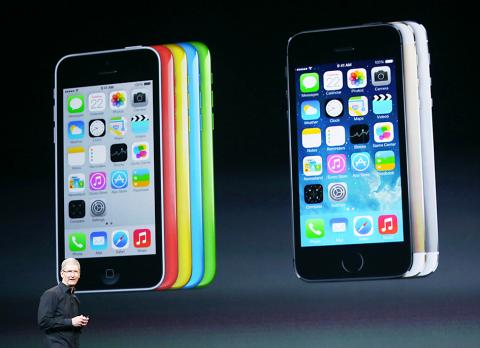Apple Inc’s profits and margins slid last quarter, despite selling 33.8 million iPhones, while its Greater China revenue climbed just 6 percent even though two smartphone models hit store shelves in its second-largest market last month.
Wall Street had hoped for a stronger beat on quarterly sales after the company predicted last month that its revenue and margins would come in at the high end of its own forecasts.
Apple chief executive Tim Cook predicted a “really great” holiday season — a crucial time for Apple as its new iPads go up against Amazon.com Inc’s Kindle Fire and its new iPhones compete with lower-cost gadgets made by Samsung Electronics Co and other rivals running Google Inc’s Android software.

Photo: Reuters
However, revenue from Taiwan, China and Hong Kong climbed just 6 percent to US$5.7 billion in the quarter, despite the iPhone 5C and 5S going on sale in the region last month. The previous generation of the iPhone 5 only began selling in China in December last year, meaning that comparisons should have benefited from a more typical quarter in that year, analysts said.
Sales grew by about 24 percent from the previous quarter, or by about US$1.1 billion, but that lagged behind the about US$1.4 billion that Apple managed to tack on in the final quarter of last year.
“It does raise the question, how well is Apple doing really, in China?” JMP Securities analyst Alex Gauna said.
“Apple is a very healthy company,” he said, but added: “If you look at the last few quarters, and even with the guide, it’s not much of a growth company.”
Cook told analysts on a conference call that results from China were “pretty good,” but acknowledged room for improvement.
“We obviously want to do better,” he said.
Cook did not address the overall popularity of the iPhone 5C on his call with analysts, but mentioned there was “a very significant backlog” for the more expensive 5S.
Apple on Monday said it expected revenue of between US$55 billion and US$58 billion this quarter, outpacing Wall Street’s forecast for about US$55.65 billion.
Gross profit margin for the quarter ended last month was 37 percent, down from 40 percent a year ago as intense competition from the likes of Samsung took a toll. That was about level with analysts’ average 36.9 percent forecast.
Apple shares, which have gained 17 percent since its upbeat forecast last month, slid as much as 5 percent on Monday before recovering after Cook said the company will continue studying its capital return program, addressing recent demands by investors to share more of its cash hoard.
Apple is increasingly hard-pressed to fend off rivals.
Strategy Analytics estimated on Monday that Apple’s market share slipped to 13.4 percent in the calendar third quarter from 15.6 percent previously, while Samsung led with 35.2 percent.
As growth tapers off, some shareholders have become increasingly aggressive at seeking a bigger return of cash. Billionaire Carl Icahn, who owns 4.7 million Apple shares, has led the charge, demanding the company initiate a tender offer to buy back US$150 billion of its stock.
Cook told analysts the company would continue to seek shareholder input on its capital return program and announce any changes in the first part of the new calendar year.
Apple said it sold 33.8 million iPhones last quarter, approximately in line with expectations for between 33 million and 36 million.
It sold 14.1 million iPads during the third quarter, up very slightly from 14 million the previous year, and moved 4.6 million of its Mac computers, down from 4.9 million a year ago.
Apple’s revenue for the quarter was US$37.5 billion, surpassing of Wall Street’s average forecast of US$36.8 billion, according to Thomson Reuters I/B/E/S.
The company’s earnings per share slid for the third straight quarter to US$8.26, but beat analysts’ average estimate of US$7.94.

CHIP RACE: Three years of overbroad export controls drove foreign competitors to pursue their own AI chips, and ‘cost US taxpayers billions of dollars,’ Nvidia said China has figured out the US strategy for allowing it to buy Nvidia Corp’s H200s and is rejecting the artificial intelligence (AI) chip in favor of domestically developed semiconductors, White House AI adviser David Sacks said, citing news reports. US President Donald Trump on Monday said that he would allow shipments of Nvidia’s H200 chips to China, part of an administration effort backed by Sacks to challenge Chinese tech champions such as Huawei Technologies Co (華為) by bringing US competition to their home market. On Friday, Sacks signaled that he was uncertain about whether that approach would work. “They’re rejecting our chips,” Sacks

NATIONAL SECURITY: Intel’s testing of ACM tools despite US government control ‘highlights egregious gaps in US technology protection policies,’ a former official said Chipmaker Intel Corp has tested chipmaking tools this year from a toolmaker with deep roots in China and two overseas units that were targeted by US sanctions, according to two sources with direct knowledge of the matter. Intel, which fended off calls for its CEO’s resignation from US President Donald Trump in August over his alleged ties to China, got the tools from ACM Research Inc, a Fremont, California-based producer of chipmaking equipment. Two of ACM’s units, based in Shanghai and South Korea, were among a number of firms barred last year from receiving US technology over claims they have

BARRIERS: Gudeng’s chairman said it was unlikely that the US could replicate Taiwan’s science parks in Arizona, given its strict immigration policies and cultural differences Gudeng Precision Industrial Co (家登), which supplies wafer pods to the world’s major semiconductor firms, yesterday said it is in no rush to set up production in the US due to high costs. The company supplies its customers through a warehouse in Arizona jointly operated by TSS Holdings Ltd (德鑫控股), a joint holding of Gudeng and 17 Taiwanese firms in the semiconductor supply chain, including specialty plastic compounds producer Nytex Composites Co (耐特) and automated material handling system supplier Symtek Automation Asia Co (迅得). While the company has long been exploring the feasibility of setting up production in the US to address

OPTION: Uber said it could provide higher pay for batch trips, if incentives for batching is not removed entirely, as the latter would force it to pass on the costs to consumers Uber Technologies Inc yesterday warned that proposed restrictions on batching orders and minimum wages could prompt a NT$20 delivery fee increase in Taiwan, as lower efficiency would drive up costs. Uber CEO Dara Khosrowshahi made the remarks yesterday during his visit to Taiwan. He is on a multileg trip to the region, which includes stops in South Korea and Japan. His visit coincided the release last month of the Ministry of Labor’s draft bill on the delivery sector, which aims to safeguard delivery workers’ rights and improve their welfare. The ministry set the minimum pay for local food delivery drivers at